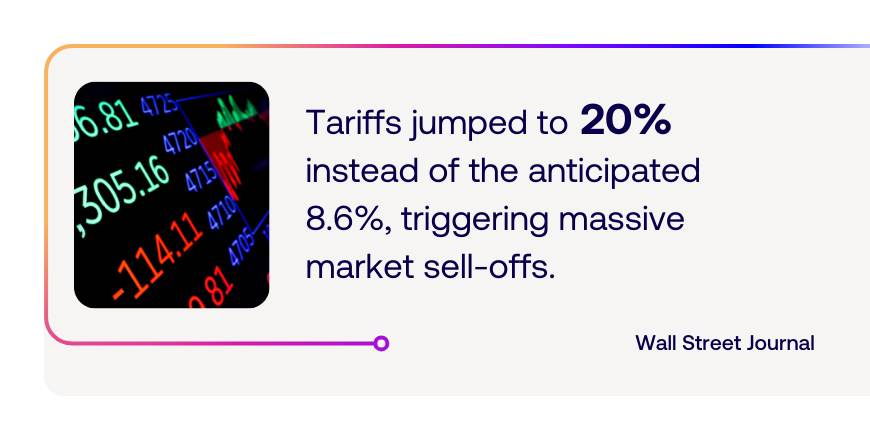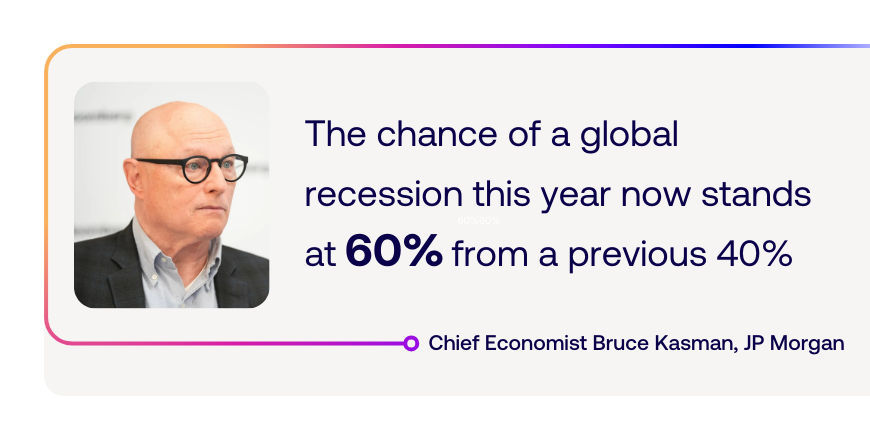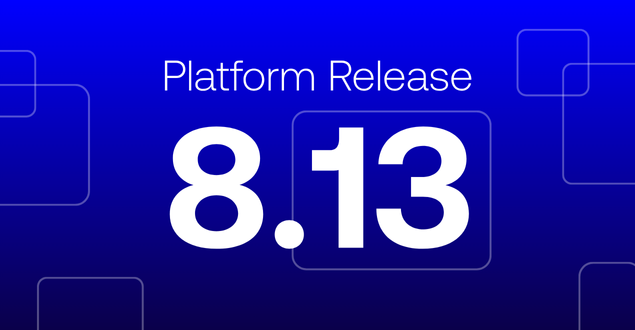
Table of Contents
Tariffs, turbulence & tactics: how to navigate the Trump tariff shockwaves
This week, aggressive tariff escalations from the Trump administration have triggered cascading effects, from record-breaking losses in stock markets to disruptions across various industries. Already, it’s reshaping client portfolios, operational strategies, and long-term economic outlooks.
For financial institutions, navigating this volatility requires a clear understanding of the risks and actionable strategies to mitigate their impact. By prioritizing agility, real-time intelligence, and innovation, firms can not only weather the storm but position themselves for resilience.

What just happened?
On April 2, a date Trump named “Liberation Day”, and what some industry leaders succeeded to call “Obliteration Day,” the Trump administration announced a substantial increase in tariffs. Tariffs jumped to 20% instead of the anticipated 8.6% triggering rapid market sell-offs. This moment marked the most aggressive protectionist move in nearly a century.
China quickly retaliated with its own escalating measures, and fear gripped global markets. The ripple effects were immediate, with the S&P 500 dropping 6% and nearing bear market territory, according to Dow Jones Market Data, over $11 trillion in U.S. stock market value has been wiped out since mid-January, and $6.6 trillion of that drop occurred in just two days following the tariff announcement.
Global market fallout
- U.S. Markets: S&P 500 fell 17% since February, marking one of its fastest declines in recent history.
- European Markets: Germany’s DAX and the UK’s FTSE 100 dropped significantly, with the latter experiencing its steepest fall in five years.
- Asian Markets: Japan’s Nikkei 225 also suffered, with slight recovery seen later.
Earlier this week the VIX Index reached the highest level since March 2020. Investor uncertainty has reached boiling point, with fears of recession intensifying. According to JP Morgan, the chance of a global recession this year now stands at 60%, from a previous 40%, if the tariffs are sustained.
But the volatility this week has continued. Trump announced that tariffs on Chinese goods would increase at least 125% with immediate effect. And for the rest of the world, all US exports are now subject to a blanket 10% tariff. This has caused significant soars in some stocks. For instance, the S&P 500 increased by 9.5%, the largest 1-day increase since 2008. While this may appear promising, there is still a lot of uncertainty, and the global economic situation is highly volatile. Here we explain what this could mean for financial institutions and share some ways to help navigate this market volatility.

Why could these tariffs be so damaging?
Tariffs increase the cost of imported goods, forcing businesses to either absorb these additional costs or pass them on to consumers. This disrupts pricing strategies and squeezes margins. Equally, these additional costs will lead to increased prices which ultimately reduces consumers’ purchasing power, leading to weaker economic demand. For example, The Guardian notes that rising import prices have halted consumer confidence, further threatening global GDP.
Furthermore, global supply chains rely on the free flow of goods. Trade restrictions create bottlenecks, delay shipments, and increase costs, hitting manufacturers particularly hard. These tariffs impact investor sentiment. The fear of long-term economic instability leads to sell-offs, exacerbating market volatility and making firms less likely to pursue major investments or mergers, which we have already seen in the stock market this week.
Finally, while these tariffs were not intended to directly affect banks and other financial institutions, with the above-mentioned market losses we are likely to see longer-term impacts following this week. For example, we expect a significant decline in Mergers and Acquisitions (M&A) and Initial Public Offerings (IPO) activity. Both M&As and IPOs are historically a significant revenue stream for banks and typically slow dramatically in economic uncertainty. Slower deal flow and asset write-downs will be raising red flags across boardrooms.
How should you navigate this market volatility?
Modernize technology infrastructure & strengthen communication
Legacy systems struggle under periods of high volatility, and this is no different. Today, amid rapidly changing tariff rules and policy shifts, speed is survival. We recommend:
- Deploying agile application development tools for instant updates to compliance and trading systems.
- Building real-time dashboards for internal teams and clients to track key market and regulatory changes.
- Use automated systems wherever possible to deliver personalized client reports, ensuring transparency, compliance, performance and build trust under pressure. Upgrading to automated infrastructure helps to ensure you can pivot faster.
Stay agile, calm and data driven
When markets crash and political headlines dominate, emotional decision-making becomes the biggest threat. During the COVID-19 crash of 2020, those who panic-sold at the bottom missed one of the fastest recoveries in modern market history — the S&P 500 rebounded over 76.1% over a year. Just some of our recommendations include:
- Ensuring your investment teams share a unified, real-time view of the market through robust data and workflow tools—enabling quick, collaborative decision-making in volatile conditions.
- Staying agile with the right technology. Leverage innovative platforms to build custom solutions that monitor market shifts, tariff exposure, and risk in real time—keeping your strategy responsive without losing sight of long-term objectives.
- Leading with perspective and discipline. Educate teams and clients on historical recoveries to maintain confidence and discipline, even during market turbulence.
Reassess risk exposure & diversify
Geopolitical shocks like sudden tariffs can disrupt entire sectors overnight. In 2018, steel and aluminum tariffs triggered sharp drops in related manufacturing stocks. Investors with diversified holdings — including gold, Treasury bonds, or volatility-tracking ETFs, saw much smoother performance. We recommend hedging intelligently and aligning risk with your financial goals.
- Conduct stress testing and simulate multiple geopolitical scenarios to gauge potential outcomes. Build digital dashboards that provide real-time updates on trade-related risks.
- Consider rebalancing to diversify your portfolio or increase allocations to non-correlated assets like precious metals and inflation-protected securities.

Turn volatility into opportunity
While unprecedented volatility makes headlines, it also creates opportunities for those equipped to act. Forward-thinking firms that invest in agility, real-time intelligence, and client-centric approaches will not just endure—but thrive in this turbulent financial landscape.
The path forward for financial organizations lies in leveraging tools and strategies that enable speed and adaptability. Get in touch today to learn more on how we can help you enhance operational efficiency, simplify technology modernization and provide the key to navigating this chaos.











